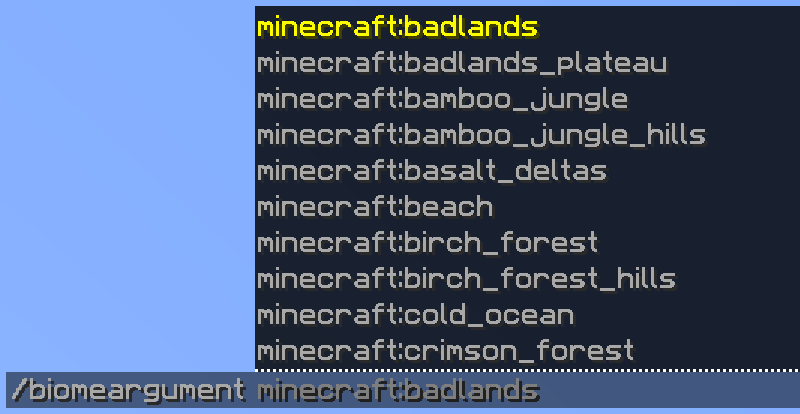Biome arguments

In Minecraft 1.16, they added the ability to refer to in-game biomes. The CommandAPI implements this using the BiomeArgument. As expected, this returns Bukkit's Biome enum when used.
DANGER
When using the Biome object, the CommandAPI will return null if the specified Biome could not be found, for example if a player submitted a biome from a client-side resourcepack. The CommandAPI does not return Biome.CUSTOM from the BiomeArgument.
Example – Setting the biome of a chunk
Example – Setting the biome of a chunk
Say you want to set the biome of the current chunk that a player is in. We can do this using the World.setBiome(x, y, z, biome) method for a given world. We will use this command syntax to set the biome of our current chunk:
/setbiome <biome>And we can set the biome of the current chunk as expected:
new CommandAPICommand("setbiome")
.withArguments(new BiomeArgument("biome"))
.executesPlayer((player, args) -> {
Biome biome = (Biome) args.get("biome");
Chunk chunk = player.getLocation().getChunk();
player.getWorld().setBiome(chunk.getX(), player.getLocation().getBlockY(), chunk.getZ(), biome);
})
.register();The BiomeArgument also supports returning a NamespacedKey for custom biomes. This can be done by using the BiomeArgument.NamespacedKey constructor instead of the normal BiomeArgument constructor:
// Makes a BiomeArgument that returns a Biome
new BiomeArgument("biome");
// Makes a BiomeArgument that returns a NamespacedKey
new BiomeArgument.NamespacedKey("biome");Developer's Note:
Spigot's support for custom biomes is really limited! If you have an example that lets you use custom biomes with namespaced keys, please open a GitHub issue, or reach out to us on Discord!